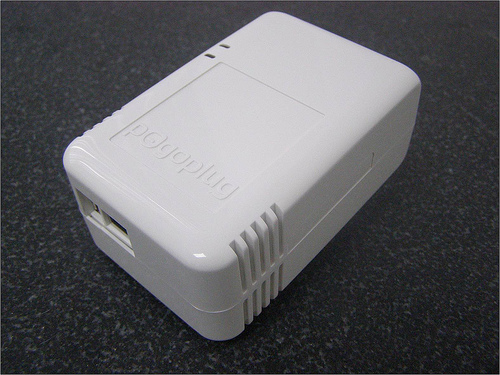Author: Joseph Moran
Review Date: 7/16/2009

Price: $99
Pros: hassle-free setup and easy remote data access and sharing via Web browser; no monthly fee; free iPhone/iPod Touch client
Cons: access to data depends on Pogoplug Web site; single USB port means a separate hub is required to connect multiple storage devices
External hard drives provide a convenient way to add large amounts of storage to a PC, but accessing the storage when you travel means setting up an FTP server or remote access software (or lugging the drive around with you). The $99 Pogoplug from CloudEngines represents a much more attractive option for getting at your data on the road by easily making any USB storage device Internet-accessible.
The $99 Pogoplug is a chunky (4 x 2.5 x 2 HWD) wall wart-style device that’s based on Marvell’s SheevaPlug integrated “plug computer”. The Pogoplug’s ostensibly designed to plug directly into a wall AC outlet, but if your outlet or power strip is short on real estate, you can alternately plug it in using a conventional power cord that’s included with the device (popping off the Pogoplug’s prongs reveals a hidden power connector).
At the bottom of the Pogoplug you’ll find a Gigabit Ethernet and a USB 2.0 port. The latter works with hard drives or flash memory drives formatted for Windows, Mac, or Linux. Supported formats are FAT32, NTFS, HFS+, ext2, and ext3. Although the PogoPlug provides only one built-in USB port, you can attach a USB hub to accommodate additional storage devices.
Setup
Getting the Pogoplug up and running is extremely simple: Connect it to power and Ethernet, attach a storage device, and then head over to my.pogoplug.com to complete the setup process by registering the device and creating an access account. (The site offers step-by-step setup instructions complete with video clips, but only the most technophobic users will need the hand holding.)
Early Pogoplug units required a rather lengthy alphanumeric ID code be entered for product activation, but this is no longer necessary as the device now supports automatic device discovery. It worked like a charm, with no need to fiddle with firewalls to open network ports, etc. All told, the Pogoplug was ready to use less than five minutes after unboxing.
Once the Pogoplug is online and activated you can access the contents of an attached drive after logging in at my.pogoplug.com. (The site connection isn’t encrypted by default but you can opt to login via SSL.) It’s worth noting that CloudEngines doesn’t burden Pogoplug users with a monthly subscription fee to get at their data. On the flip side, the Pogoplug is little more than a paperweight without the back-end servers. CloudEngines has pledged to publish the source code for the open-source community so the service could be recreated should the company go kaput.
Data Access and Sharing
The Pogoplug provides a straightforward Web interface that makes it easy to access and manipulate your data. Large thumbnails are the default file/folder view, but to fit more items on a page you can choose from two smaller thumbnail sizes as well as a detail view. You get some basic sorting and search capabilities as well– contents can be arranged in ascending and descending order by file name, date, size, and type, and you can search by keyword as well as filter contents to display only photos, music, or movies, or recently added files.
Clicking on an image thumbnail calls up the Pogoplug’s Flash-based preview applet which can browse an entire folder’s worth of images, display manual or automated slide shows, and stream MP3/MP4 audio, and FLV or H.264 video files. There’s no way to preview documents like Word or PDF files, so to view them you must download them first.
You can do basic file management chores from the Pogoplug, too. Hovering over any file or folder item with the mouse will let you rename, delete, or download it, and there’s a very nice drag-and-drop interface to copy files between folders. You can also create new folders and upload files to them, though the interface for uploading is somewhat limited–files must be selected one at a time (though you can upload several at once), and you can’t upload an entire folder.
To avoid the possibility of data corruption, a storage device must be “ejected” before disconnecting it from the Pogoplug (much as you often need to with removable drives in Windows). It would be nice if the Pogoplug provided a physical eject button, but you can only perform the action via the Web interface.
To share a folder with someone, you need only hover over it and click a sharing button. (You can only share entire folders, not individual files.) After choosing a folder, you can send share link (accompanied by a brief text message) to one or more e-mail addresses and allow specific users to upload their own files to the folder. Those receiving share links don’t need to create their own Pogoplug accounts to access the folder unless they’ve been granted upload rights (we’re not crazy about the fact that users with upload rights can also rename and delete existing files, however). You can also share a folder by publishing it via an RSS feed.
Available Applications
If you’d rather not access your files from a Web browser, the PogoPlug offers other options. One is to download a free Pogoplug Drive application (available for 32/64-bit Windows, Mac OS X, and 32/64-bit Linux) that will make Pogoplug storage appear as local hard drive on your system The app still requires a site login to access the Pogoplug, but it makes transferring data to or from the device much easier. There’s also a (free) Pogoplug app for the iPhone/iPod Touch.
The duo of an external hard drive and a PogoPlug won’t give you the level of network storage features or flexibility you’d get from a NAS device or even a router with USB storage support. But for anyone that wants reliable remote file access and sharing that’s free of setup hassles or a monthly fee, the Pogoplug is just the ticket.




